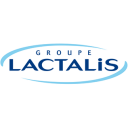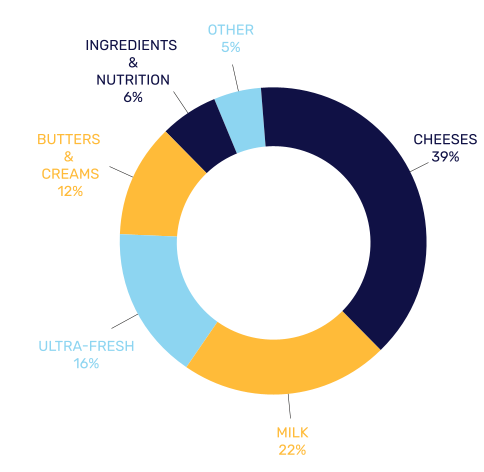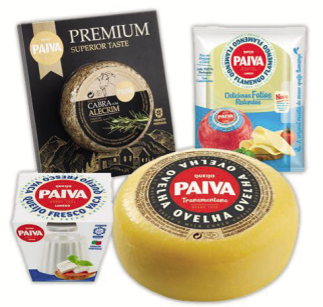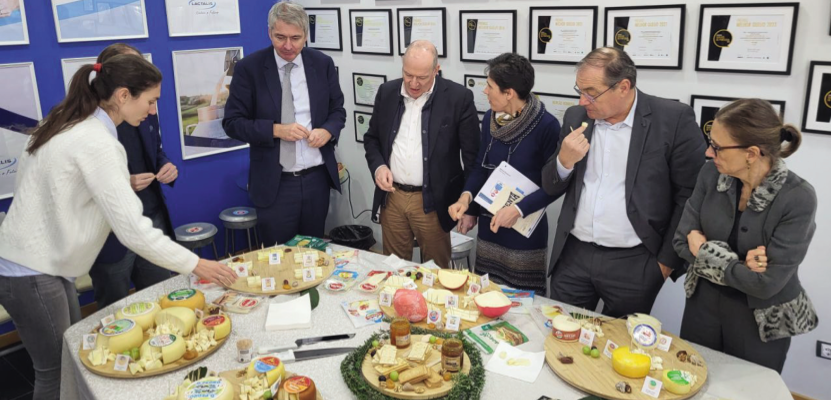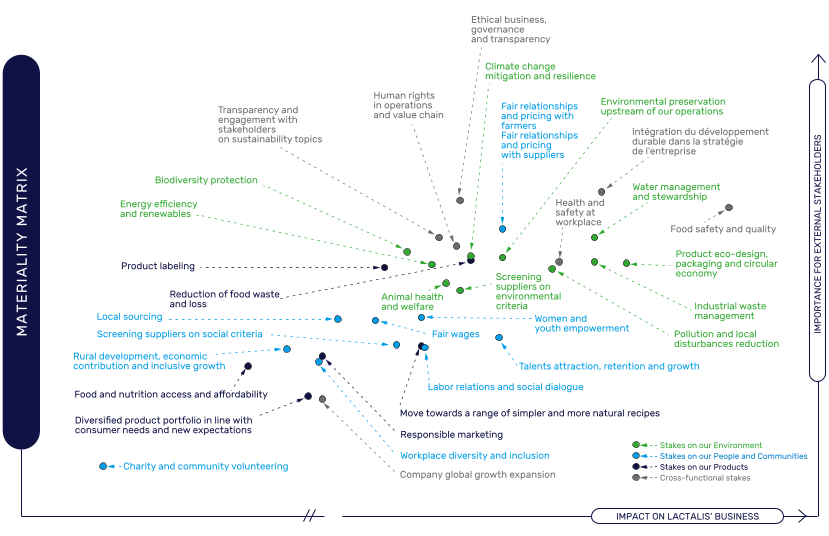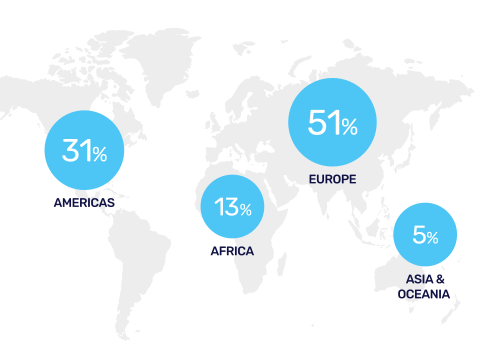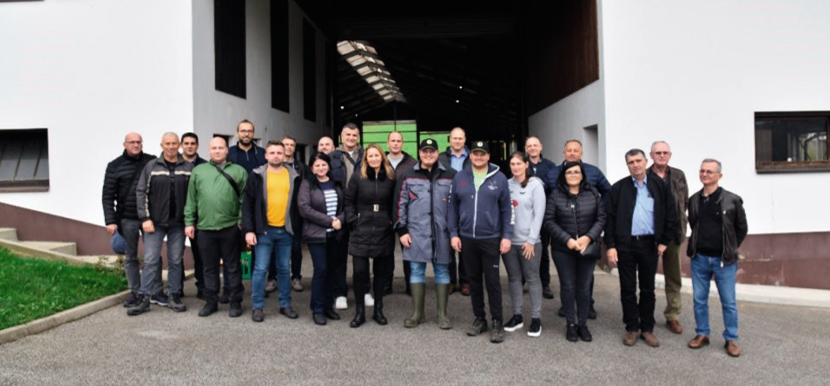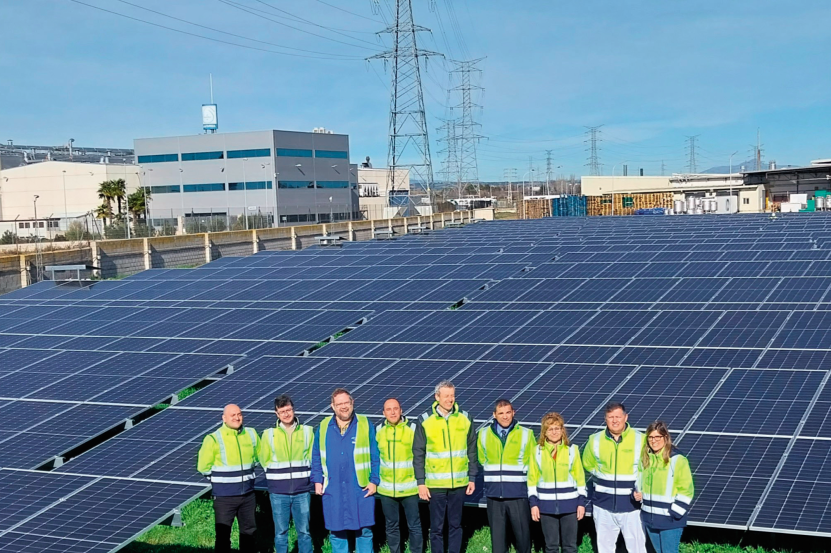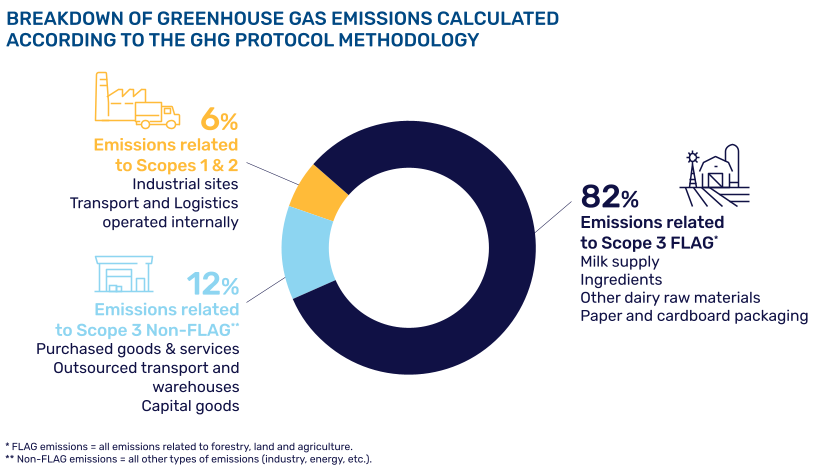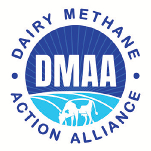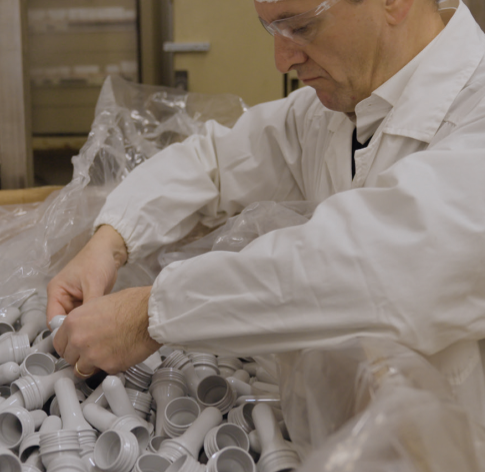SR 2024
-
Editorial
At Lactalis, we firmly believe that dairy products will play a crucial role in sustainable food. For 90 years, we have been committed to offering healthy, tasty, and accessible products while caring for the planet and future generations.
Our vision of sustainable food is part of a global approach integrating environmental, social, and demographic issues, while remaining in line with the local realities of each territory of the 50 countries in which we operate, and innovating to meet consumer expectations. Dairy products have an essential role to play in diet of today and tomorrow, thanks to their many benefits and adaptability to all regions and desires. It is this belief that guides and embodies our purpose in action: nurturing the future!
Dairy products have an essential role to play in diet of today and tomorrow, thanks to their many benefits and adaptability to all regions and desires.
We face many challenges: global warming and its consequences are one of the most pressing. Our climate commitment is unequivocal: to cut emissions throughout our value chain (Scopes 1, 2, and 3) to help achieve global carbon neutrality by 2050. These environmental issues are not limited to climate. Water shortages and the risk of biodiversity collapse directly affect our agricultural ecosystems, prompting us to adopt more sustainable practices. This adaptability is essential to ensure the sustainability of our activity in response to the rise in extreme phenomena.
We are also committed to integrating sustainability into all stages of our production. Thus, animal welfare is a key issue for our partnering farmers. It is our responsibility to support them in a process of continuous improvement, aimed at gradually eliminating the most problematic practices and generalizing the implementation of the best. Training, audits, and awareness-raising activities are deployed on farms to meet the targets that we have set collectively.
At the same time, consumers' expectations are changing: they are looking for products that are not only tasty and healthy, but also eco-designed. The packaging of dairy products is essential to preserve food safety and organoleptic quality. However, as a source of waste and pressure on natural resources, our role is to innovate to reduce their impact. We engage with our stakeholders to promote a circular economy for packaging and are taking action on three fronts: "right pack", aiming to reduce packaging without compromising product quality; better circularity with sustainable and recycled materials; and finally, raising consumer awareness to encourage the collection and recycling of packaging.
If I had to highlight one particularly significant event for 2024, it would undoubtedly be the validation of our climate roadmap by SBTi (Science-Based Targets Initiative). This would not have been possible without the energy and dedication of the Group's teams, who have mobilized to implement our ambition to reduce our emissions. A big thank you to them all! We are building a culture of profitable and responsible performance. A big thank you also to our many partners around the world. Together, we can ensure the sustainability of our model while preserving our planet's essential resources.
Looking to the future, we are determined to meet the challenges of tomorrow. Implementing our environmental roadmap with the same regularity and discipline while continuing to create profitable and responsible growth will be crucial. By offering products that respect local traditions and the environment, we are working towards a future where health, pleasure, and responsibility come together.

Agnès
Baudet-BarbezantGroup General Manager
for Quality, CSR & Crisis Management
Our transition to circular packaging reached a milestone in 2024. I would like to highlight the collective commitment of our Purchasing, R&D, Quality, and CSR teams, as well as the countries, whose collaboration has been decisive. We have contributed to the development of two recycling channels: opaque PET bottles in Italy and PS Yogurt pots in France.
Faced with new regulations such as the CSRD and the PPWR, we are ready to intensify our efforts, rethink our indicators, and strengthen our internal and external cooperation to move ever closer to a circular economy.
Promotion of animal welfare continues to be a partners and employees priority, and I am delighted that all our dairy technicians have now been trained in this area. Since 2021, they have assessed more than 10,000 farms in 21 countries with regards to animal welfare, which equates to around 50% of our direct partnering farmers in these countries. Thanks to this long-term work, we achieved Tier 4 in the latest international BBFAW rankings; we are among the 20% most mature companies in terms of animal welfare. This ranking is a testament to our ongoing commitment to ensuring exemplary agricultural practices.

We are at a crossroads; the time has come to move from ambition to action. But it's not that easy, and it's thanks to courageous leaders that we will be able to put social and environmental issues at the heart of our model, to deliver profitable and responsible growth.
We achieved these first steps thanks to our partners and many company employees who are passionate and concerned about contributing to a better future for next generations. I would like to sincerely thank them and assure them of my commitment to working alongside them to continue this dynamic and contribute to protecting our planet!
Our “Nurturing the future” mission comes into its own when economic performance and commitment to the planet and communities come together, because one cannot prosper sustainably without the other.
In 2024, we took meaningful steps toward a more concrete and tangible approach to sustainability. This progress was also the result of collective mobilization and commitment. And our work is bearing fruit, particularly on the main issues that structure our action such as the fight against global warming, the circularity of packaging, animal welfare, the promotion of inclusion and diversity.
One topic I am personally very attached to is the issues of inclusion and diversity. The first results are the fruit of the remarkable work carried out by our HR teams. In June 2024, we officially launched our DEI (Diversity, Equity, and Inclusion) initiative in all our countries. A training course has been designed to raise awareness among our employees about this issue. Empowerment and mentoring programs have also been launched in several countries, particularly in Brazil and Canada.
Regarding our commitment to climate action, I am particularly proud that our emissions reduction targets have been officially validated by the Science-Based Targets initiative (SBTi). It is a tremendous recognition of the passionate and collaborative work of our teams around the world. This validation encourages us to further accelerate our decarbonization, with already very concrete actions. In 2025, we will continue this momentum with major projects such as the installation of biomass boilers in Craon and Mayenne, which will enable an annual reduction of around 32,500 tons of CO2e.
Our Milk Supply teams stand out for their commitment: more than 5,000 carbon diagnostics were carried out with our partner farmers in 21 countries. These diagnostics strengthen our expertise, raise farmers' awareness, and enable the deployment of decarbonization plans on farms. To further develop this approach, we have integrated climate criteria into the milk remuneration paid to farmers, as in Sweden, the United Kingdom, and soon in France.
-
1. Presentation of Lactalis
Created in 1933 by André Besnier in Laval, Lactalis has been a family business for three generations. Lactalis is developing its activities to respond to its mission: to offer healthy, tasty, and affordable products every day that bring us closer together. Driven by a passion for Dairy, Lactalis strives to cultivate dairy know-how all over the world, as well as a wide range of tastes and products with high nutritional value. Lactalis intends to preserve, promote, and share these with as many people as possible.
Lactalis has been developing dairy and cheese know-how since the company was founded, strengthening this expertise as it has grown. It offers consumers a wide range of dairy products in all categories: cheeses, fluid milk, yogurts, ultra-fresh dairy products, butters and creams, powdered formula and milk for infants and adults, clinical nutrition products, and dairy ingredients.
Lactalis collects more than 22.8 billion liters of raw milk per year from 400,000 farmers. Processing is carried out at 266 production sites located in 50 countries. Lactalis has 85,500 employees worldwide. Lactalis generated revenue of €30.3 billion in 2024.
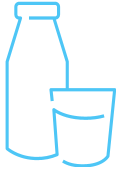
No. 1
- •Global dairy company
- •Global group in the cheese market
- •Global group in butter and cream
- •Global player in PDOs and raw milk cheeses

No. 2
- •Global group in the ultra-fresh dairy products market
- •Global group in the fluid milk market
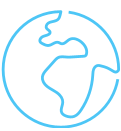
No. 9
- Global food company
Founded in 1986, Sequeira & Sequeira was first a food wholesaler before expanding its activity in 1992 with the acquisition of Lacticinios do Paiva. This cheese company specializes in the manufacture of reputable and high-quality cheeses, ranging from traditional pressed cheeses to fresh cheeses under the Paiva brand. In the 2000s, the development of wholesale activities in Mozambique and Cape Verde gave a new international dimension to Sequeira & Sequeira. This acquisition allowed Lactalis to develop its production and sales of local cheeses in Portugal, but also to complete its product offering.
Our areas
of actionIndicator
nameTargets
2023 Results
2024 Results
Progress
Contribution
to the SDGsCOMMITTING TO PEOPLE AND TERRITORIES
Promoting diversity
% of women
in leadership positionsAim for a balance in management positions by 2033
28.2%
27.7%



OFFERING HEALTHY, TASTY AND ACCESSIBLE PRODUCTS
Making food quality and safety an absolute priority
% of industrial activities certified according to at least of the 5 ISO 22000, FSSC 22000, IFS, BRC, and SQF standards
100%
by 2026
85%
88%




PROTECTING THE PLANET AND ITS RESOURCES
Preserving biodiversity
% of volumes of virgin paper covered by a sustainable certification
100%
by 2023
89.8%
95.9%



% of purchased volumes of palm oil and derivatives covered by
a sustainable certification100%
by 2025
87%
92%




Promoting the circular economy
Percentage of recycled
material in our packaging> 30%
31.3%
32.3%




Metric tons of
PVC in packagingAim for
elimination
by 2025
616
866


% of packaging
recyclable by designAim for 100%
in 2025
83.8%
82.8%



Caring for Animals all along our value chain
% of dairy technicians in the 21 pilot countries(1) regularly trained in animal welfare using the CowSignals® method (at least once every 3 years)
100%
by 2024
79%
97%



% of direct annual volume of collected raw milk in the 11 pilot countries(2) coming from partnering farms regularly assessed on animal welfare, according to the Lactalis internal assessment method (at least once every 3 years)
100%
by 2025
40%
55%



% of annual volume of purchased shell eggs worldwide coming from cage-free systems
100%
by 2025
100%
100%



% of annual volume of purchased egg products worldwide coming from cage-free systems
100%
by 2025
91.85%
92.06%


 1)Australia, Belgium, Brazil, Canada, France, Germany, Italy (excluding the Ambrosi subsidiary acquired in 2023), Spain, Sweden, the United Kingdom, and the United States of America (Lactalis American Group and Lactalis US Yogurt subsidiaries), Croatia, the Czech Republic, the Netherlands, Poland, Portugal, Romania, Slovenia, South Africa, Switzerland and Turkey2)Australia, Belgium, Brazil, Canada, France, Germany, Italy (excluding the Ambrosi subsidiary acquired in 2023), Spain, Sweden, the United Kingdom, and the United States of America (Lactalis American Group and Lactalis US Yogurt subsidiaries)
1)Australia, Belgium, Brazil, Canada, France, Germany, Italy (excluding the Ambrosi subsidiary acquired in 2023), Spain, Sweden, the United Kingdom, and the United States of America (Lactalis American Group and Lactalis US Yogurt subsidiaries), Croatia, the Czech Republic, the Netherlands, Poland, Portugal, Romania, Slovenia, South Africa, Switzerland and Turkey2)Australia, Belgium, Brazil, Canada, France, Germany, Italy (excluding the Ambrosi subsidiary acquired in 2023), Spain, Sweden, the United Kingdom, and the United States of America (Lactalis American Group and Lactalis US Yogurt subsidiaries) -
2. An integrated approach ensuring the sustainability of the company’s actions
-
2.1Strategic pillars and outlook
Lactalis seeks to offer the pleasure and nutritional benefits of dairy products to as many people as possible. The dairy sector also offers prospects for development around which Lactalis intends to mobilize its talent and stakeholders for profitable and responsible growth. These elements have structured the definition of Lactalis’ corporate project for 2033, the 100th birthday of its creation. It is divided into four pillars: people, products, performance, and the planet.
2.1.1Consumption of dairy products and worldwide
Dairy products enjoy a positive image around the world, particularly in emerging countries, where their consumption is essential to providing the population with essential nutrients at an affordable cost. The main categories each have their own image: nutrition and health for milk, pleasure and savoir-faire for cheese, and taste and enjoyment for chilled dairy products.
Lactalis remains convinced that dairy products are a fundamental part of a healthy and sustainable diet (for all ages), and that there is no plant-based nutritional alternative to dairy products. Lactalis believes that dairy and plant-based products are complementary, and each have their own place as part of a balanced diet.
-
2.2Lactalis' business model
Creating value for all since 1933, with a hands-on approach

Natural resources
MISSIONEmployees
Passionate women and men, recognized for their expertise, with a key role in rural development
85,500 employees
Iconic brands
A unique portfolio of iconic and historic international and local brands. Brands synonymous with quality, taste, pleasure, and sharing
Over 250 brands
(of which 31 with revenue > €100 million)
Purchased goods & services
A close relationship with our global and local suppliers and farmers
22.8 billion liters of milk collected
Natural resources
A resource use strategy based on the principles of sobriety, efficiency and transition
266 production sites
Operations & innovation
Robust quality processes. An industrial DNA preserving and transmitting world dairy cultures and know-how. Operations with local positive socio-economic impact. An innovation strategy for our consumers and to reduce our environmental impacts
World leader in PDOs (38)
Sales channels
An omni-channel sales strategy, sharing dairy cultures with local & export customers
Family shareholding
A family shareholding ensuring stability, an agile entrepreneurial spirit, and a long-term strategy
100% of the shareholding held by the founding family
A family company offering healthy, tasty, and accessible products that bring us closer together every day


ValuesAmbition
Setting higher goals
in the daily management
of the business,
and continually developing one’s professional
and individual capabilitiesCommitment
Showing true entrepreneurship, both individually
and collectively.
Being reliable, accountable,
and loyalSimplicity
Acting with transparency, pragmatism,
and an open
mind, while
working
effectively
and being
results-oriented -
Ambition
Profitable and responsible growth

The ecosystem
and shared values
Main ambitionsEmployees
A safe, caring, and attractive working environment, a demanding health and safety policy, social dialogue, competitive salaries and benefits, and a talent development policy
Consumers & Customers
A Quality organization ensuring food safety. A wide range of healthy, tasty, and accessible dairy products, mostly made of milk. Helping consumers to adopt balanced diets worldwide via innovative sales channels and services
Industry
A leader engaged with national dairy federations to collectively develop qualitative and sustainable standards, and shape the future of our industry
Farmers
A close and mostly direct relationship with 400,000 farmers in 50 countries. Technical advice for a sustainable production of quality milk. 650+ intermediate milk collection centers in remote rural areas
Suppliers
A ripple effect on the activity of global and local suppliers through the Group’s international operations, and the exploration of partnerships favorable to innovation
Environment
Resource-efficient processes, contributing to our mission to feed the world with sustainable nutrition
For our activities
Economically profitable activities, favoring a continuous development of our local communities and territories
For our employees
Zero workplace accidents
Zero occupational diseases
Managerial surveys in 50 countries
100% of our selected HR officers trained in Lactalis Labor and Employee Relations Way
For our consumers
100% of packaging will bear waste management information by 2025 (1)
100% of industrial activities certified according to at least 1 of the 5 certificates (ISO 22000, FSSC 22000, IFS, BRC, SQF) by 2026
For our partners
Increased dialogue and partnerships with our stakeholders
For the Planet
-46.2% of GHG emissions (2) by 2030 (scopes 1 & 2)
-30.3% of GHG emissions by 2030 (Scope 3 FLAG) (3) (4),73.8% of our suppliers and customers (5) in terms of emissions with science-based climate targets by 2028 (non-FLAG Scope 3) (6),
Carbon Net Zero by 2050 (7)
Zero deforestation by the end of 2025100% of virgin paper covered by sustainable certification by the end of 2023 (1)
Using an eco-design tool for 100% of current and future packaging solutions for our pillar products and packaging for product innovations by 2025 (1)
Minimum 30% recycled materials in our packaging (1)
Aim for the elimination of PVC in our packaging by 2025 (1)
Aim for 100% recyclable packaging by design in 2025 (1)
Aim for 100% recyclable packaging in practice in 2033 (8)100% of our direct milk volumes assessed on animal welfare by 2025 in 11 pilot countries (9) and by 2027 in 10 additional countries (10)
100% of our dairy technicians trained in animal welfare by 2024 in the 11 pilot countries and the 10 additional countries
100% of volumes of eggs and egg products used in our recipes coming from cage free systems by the end of 2025
- (1)Ambition on a set of 23 countries accounting for 85% of Lactalis Group revenue in 2019. All acquisitions from December 2019 excluded at this stage.
- (2)Greenhouse gases.
- (3)FLAG: Forest, Land & Agriculture.
- (4)Commitment to 67% of Lactalis Scope 3 FLAG GHG emissions.
- (5)Covering purchased goods and services, capital goods, fuel and energy activities, transport, and distribution, as well as the transformation of sold products.
- (6)Commitment to 67% of Lactalis Scope 3 non-FLAG GHG emissions.
- (7)Contribute to the achievement of carbon neutrality at Group level
- (8)Ambition for countries with an Extended Producer Responsibility EPR scheme, amid a set of 23 countries accounting for 85% of Lactalis Group revenue in 2019. All acquisitions from December 2019 are excluded at this stage.
- (9)Australia, Belgium, Brazil, Canada, France, Germany, Italy (excluding the Ambrosi subsidiary acquired in 2023), Spain, Sweden, the United Kingdom, and the United States of America (Lactalis American Group and Lactalis US Yogurt subsidiaries).
- (10)Croatia, the Czech Republic, the Netherlands, Poland, Portugal, Romania, Slovenia, South Africa, Switzerland, and Turkey.
-
2.3CSR vision and strategy: uniting around shared commitments
The Lactalis Group’s CSR strategy is part of the company’s strategy for profitable and responsible growth. Creating value for the company and its stakeholders is at the heart of this project, which should support the necessary transition of production and distribution systems.
For Lactalis, the specificities of dairy products enable them to be part of the solution for sustainable nutrition. Lactalis is thus working to reduce its impacts on the environment and the climate throughout its value chain. Its efforts, therefore, also cover water management, waste treatment and the resource use. As a leader in the dairy sector, Lactalis wishes to take advantage of its global positioning to accelerate this sectoral movement. The development of women and men, and the communities and regions in which the Group operates, are also key to the sustainability of its activities.
Lactalis' CSR Roadmap contains numerous topics and is based on the United Nations Sustainable Development Goals and the 10 fundamental principles of the Global Compact, of which Lactalis is a participant.
Our purpose in action “Nurturing the future”
On the Group’s 90th anniversary, Lactalis unveiled its purpose in action of “Nurturing the future”.
By setting this ambition for itself, Lactalis is clarifying the role it wants to play in the world. The company is opting to nurture a responsible future by committing to offering the best, locally sourced dairy products to help everyone grow.
Since 1933, Lactalis has made its choice of dairy products. Based on a pioneering intuition, the company decided to organize the collection of the milk, its processing, and its packaging, and created a reliable and efficient model that has enabled as many people as possible to enjoy the unparalleled benefits of dairy products.
By continuing to innovate from generation to generation, Lactalis has developed, refined, and shared its expert know-how to develop dairy traditions and bring into homes around the world, through a unique portfolio of brands, which is deeply rooted in the daily lives of consumers.
Faced with increasingly critical demographic, health, and environmental issues, Lactalis is convinced that dairy products have a role to play in current and future diets. As the world leader and leading expert, Lactalis has a responsibility to nurture the future.
2.3.1CSR governance
In accordance with its model based on the autonomy of its subsidiaries, Lactalis wishes to maintain a local CSR approach, mainly driven by field initiatives. However, in order to drive a convergence of efforts on shared challenges and achieve its ambitious objectives, Lactalis has developed a CSR governance at the level of the main links of its activities and decision-making bodies:
- •the CEO of Lactalis group is the company’s highest decision-making body on CSR strategy. He has been involved at all stages of the selection of priority sustainability matters (climate, packaging, animal welfare) and validates new issues for consideration and the strategy. He is updated on a monthly basis on the progress of projects and receives a comprehensive half-yearly update on the CSR strategy, in which the Chief Operating Officer is involved;
- •the Group Management Committee is the company’s second-highest decision-making body on the CSR strategy. It discusses and validates the strategy proposals for each issue. It is informed every six months of the implementation of the CSR roadmaps for each issue and the associated performance;
- •the General Manager for CSR, Quality and Crises management reports directly to the CEO of Lactalis and is in charge of proposing a CSR strategy for Lactalis, in collaboration with the Group CSR Department.
- •the Group CSR Department:
- –coordinates the implementation of the Group's CSR strategy and its update with the Expert services.
- –ensures the consistency of methods and reporting processes, the deployment of cross-functional tools and the monitoring of performance indicators,
- –coordinates the entire non-financial information and performance auditing process,
- –manages an international network of internal CSR officers,
- –ensures and develops dialogue and transparency with internal and external stakeholders. In particular, it is responsible for developing and facilitating an internal CSR culture, notably through training and the organization of events and webinars.
For each CSR issue, the Group’s CSR Department leads or co-leads the Corporate working committees, which are often multifunctional. For each issue:
- •an operational working group establishes forward-looking thinking and develops a proposal for strategy, policy, action plans and reporting methods, both at consolidated Group level and by country. It brings together members of the Group CSR Department and technical experts from other Expert services. In line with Lactalis' strong local roots, the working groups bring together technical experts from each country;
- •a Strategic Committee discusses and validates these proposals and submits them to the Group Management Committee for approval. It is made up of the working group’s coordinators, the CSR, Quality and Crisis management General Manager, and the General Managers of the Expert services involved.
In particular, Strategic Committees have been set up for the Group’s priority issues: Climate, Responsible Packaging, Animal Welfare.
The Group CSR Department coordinates and leads an international network of CSR referents in the main countries and subsidiaries. 22 countries are represented in this network; they represent the bulk of the Lactalis Group’s activities and its impact by issue(1). The CSR referents are responsible locally for:
- •establishing CSR governance involving the local General Manager and his or her Management Committee;
- •developing a CSR strategy tailored to the local context and aligned with the group’s commitments, in collaboration with the General Manager and the CODIR of the country or the division;
- •coordinating the implementation of roadmaps by issue and the ensuring reporting;
- •developing and facilitating an internal CSR culture.
-
2.4Main CSR challenges and risks
2.4.1Materiality matrix and identification of the main challenges
To determine its CSR approach and strategy, Lactalis combines the risk analysis prepared by the Expert services (see section) and its materiality analysis. Lactalis wanted to build this approach with its stakeholders: in 2020, 175 internal (30%) and external (70%) stakeholders were consulted.
A broad range of partners had to rank the relative importance of a selection of 33 CSR topics, pointing at those on which the actions and commitments of Lactalis should have the most impact. The results were presented to the Group’s Management Committee and were used to draft the Group’s CSR Roadmap, based on three immediate priorities:
- •climate and reducing the carbon footprint;
- •the circular economy and responsible packaging;
- •animal welfare.
Lactalis group materiality matrix
In 2023, Lactalis launched a project to update this matrix, via a double materiality study, in anticipation of future CSRD (Corporate Sustainability Reporting Directive) requests. Lactalis chose an external expert firm to assist with this project. This work made it possible to seek the opinions of the Group’s internal and external stakeholders again in 2024.
-
2.5Guaranteeing fair practices
Definition
-
2.6Building a positive chain of responsibility with suppliers
Definition
A transparent and responsible supply chain is essential to minimize the potential negative impacts of the Lactalis Group beyond its direct activities, both upstream and downstream. The complexity and interconnection of global and local value chains require the utmost vigilance to ensure compliance with the main principles of the Global Compact as well as ethical, social, environmental, and climatic requirements.
-
3. Committing to people and territories
-
3.1Guaranteeing employee Health and Safety
Definition
Lactalis, a global group employing nearly 85,500 people, prioritizes the health and safety of its employees, contingent workers, and subcontractors. This commitment extends to all its working environments: industrial, logistics, commercial, research, and distribution sites. The Lactalis Group’s vision is clear: to guarantee optimal working conditions while aiming for an ambitious goal of zero workplace accidents and zero occupational diseases.
-
3.2Making commitments to employees
3.2.1Lactalis employees
Breakdown of the Group's workforce in 2024
Governance
Lactalis' Human Resources Department is made up of a central department, then functional departments within the regions, countries, and divisions.
The Human Resources General Manager leads a central team at Group level, who report directly to him/her:
A Human Resources Management Committee composed of the central Human Resources Department and a certain number of international operational and functional HRDs is in charge of validating all human resources policies and actions, and then deciding how and when to roll them out Group-wide. This committee meets approximately every two to three months.
The deployment of the policies and actions, part of Group HR Stategy, is then carried out at the level of the regions, countries, and divisions, with the support of the central HR team where required.
Policy and action plans
Lactalis aims to achieve profitable and responsible growth. To achieve this objective, the group’s Management Committee has defined a new strategy for the 2023-2033 period. This strategy is based on four pillars that are key issues for the company: people, products, performance, and the planet. Each of these pillars includes priorities for action to achieve the growth objectives by 2033.
The first pillar of this strategy gives priority to current and future employees. They are the foundation of our performance and success, and it is thanks to them that Lactalis will be able to achieve its ambitions.
By 2033, Lactalis wants to accelerate and improve its human resources policy through the following objectives:
- •promoting employee engagement;
- •protecting know-how and developing the leadership model;
- •preserving the "Lactalis way of doing business" (maintaining responsibilities assigned to local managers, finance, and management control, which are two separate functions);
- •retaining and increasing the number of resources in key functions to support the company's growth;
- •developing employer attractiveness;
- •developing a strategy to improve the diversity of our teams.
In this context, the Human Resources Management Committee, in conjunction with the General Management of the areas, has set priority targets for each year. The 2024 targets were as follows:
- •implement action plans to improve the employee engagement rate measured in the Managerial survey;
- •locally deploy the “WaW” (Well-being at Work) program by implementing concrete initiatives that improve working conditions and promote a better work-life balance;
- •maintain the internal promotion rate at 70%;
- •integrate the Lactalis leadership model into annual employee reviews;
- •roll out the Group’s Diversity, Equity, and Inclusion policy in all countries in which Lactalis operates;
- •reach 27,000 learners in the Learning Factory and implement the onboarding module for all new employees;
- •continue to implement the Social Risk Assessment methodology in new countries.
-
3.3Strengthening rural communities
3.3.1Developing relationships with farmers
Definition
The FAO classifies milk as the third most produced agricultural raw material in the world, coming from nearly 150 million farms and generating around 240 million direct and indirect jobs, mainly in rural areas.
Lactalis is the world’s second largest collector, collecting around 23 billion liters of raw milk per year in around 50 countries and in partnership with some 400,000 farmers.
Although there are a multitude of situations depending on the countries in which the group operates, there are three main types of collection relationship between Lactalis and the farmers:
- •Direct collection, the approach favored by the group: Lactalis enters into direct, individual contracts with each farmer. Collections are made at each farm, and farmers receive regular visits from their Lactalis dairy technician, who can provide advice and technical recommendations to help them develop their business. This organization allows Lactalis to work closely with farmers. This approach exists in many countries. This is the case in France, for example, but with a specific feature: the majority of dairy farmers are grouped together in producer organizations in order to negotiate milk prices and contract terms;
- •Indirect collection: Lactalis does not enter into contracts directly with individual farmers but with intermediary organizations, which may be private companies or agricultural cooperatives. In this type of arrangement, the volumes purchased, the quality criteria and the prices are discussed with the intermediary organization and not with each individual farmer. This is the case, for example, in Germany and Sweden;
- •Market purchasing: In some countries, the collection of milk is centralized by local authorities. In these situations, Lactalis does not strictly speaking collect the milk but buys the quantities necessary for its activities on a “market,” at a given price. This is notably the case in Canada. In this type of arrangement, Lactalis endeavors to maintain relations with farmers through regular discussions with their representatives.
About the transportation of milk between farms (or milk collection centers, see below) and Lactalis sites, this can be done based on two main methods, regardless of the type of collection relationship between Lactalis and the farmers:
- •Internally: the trucks are owned by Lactalis and the dairy drivers are group employees. This method is, for example, used in France and Spain;
- •Externally: Lactalis uses third‑party transportation companies. In rare cases, the transportation may be provided by the farmers themselves, such as in the United States for instance, where some farmers have their own trucks.
Finally, Lactalis has a network of more than 650 milk collection centers which allow it to collect milk from farmers in the most isolated areas, helping it to boost local economies and societies.
Action plan
Several actions enable Lactalis to develop close relationships with the farmers who supply the milk the group processes daily:
Providing technical support to farmers
Lactalis aims to develop its support policy for farmers. As a world leader in dairy, Lactalis has a responsibility to develop its business activities, while implementing an organizational principle that makes it possible to meet the objectives of sustainability and profitability.
- •In Brazil, Lactalis regularly organizes field days and training for farmers in its five different milk collection regions; on average, 10 days are organized per year and per region. These technical days are planned according to the demand in each region, and topics are chosen according to the needs of farmers. Meetings generally take place on farms;
- •In France, Germany, the United Kingdom and Italy, the group regularly offers training to famers, primarily to enhance their skills in terms of animal welfare and carbon footprint.
In addition to providing technical skills, these various training courses, whether online or preferably face‑to‑face, are a way of creating links between farmers. Discussions between peers are a lever for creating farming communities and a vector of social ties in rural areas.
In 2025, as part of its climate strategy, Lactalis plans to implement pilot farms in several countries in which the group operates; it will be an opportunity to organize more training courses, technical days and to strengthen the sharing of best practices among farmers.
Strengthening the bond and providing a perspective for the future
Lactalis recognizes the importance of cultivating mutual understanding with the stakeholders in its supply chain.
Therefore, in order to promote dialogue with farmers and to strengthen the proximity between Lactalis and its partnering farmers, several actions are implemented. For example, in many countries such as in France, the United Kingdom, Australia and the United States:
- •Information meetings are organized at least once a year to discuss various topics such as milk economics and volumes aspects as well as CSR related topics;
- •The group sends monthly newsletters to its partnering farmers in order to provide technical information related to the economic situation, the milk price, new regulations or CSR;
- •Lactalis factory visits are regularly organized for the farmers.
Promoting the profession of dairy farmer and contributing to its attractiveness
Lactalis strives to promote the profession of farmer, both in its communications with producers themselves, as well as with the general public. For example:
- •In France, Lactalis highlights the best practices of certain farmers directly on its Producers portal or in the quarterly magazine “Rencontres”, distributed to all farmers delivering milk to Lactalis in the country;
- •In Australia, the United States and France, the group is regularly launching communication campaigns for the general public highlighting Lactalis partnering farmers, their daily work and achievements, throughout videos or interviews published for example on the social media.
Contributing to the renewal of generations of farmers: recruiting and supporting young people
Ensuring that new generations of farmers are coming through is an important issue for Lactalis in a context marked by the decline in milk collection in several countries, and the falling attractiveness of the profession of dairy farmer. In this context:
- •In the United Kingdom, Lactalis offers a technical support to young farmers to ensure that they are provided with tools and sufficient technical assistance when they start their profession. The group also connects the young farmers with existing farmers in order that they are offered technical advice and some mentoring.
- •In France, Lactalis proposes support to farmers during the set‑up phase by allocating volumes of milk to be produced according to the proposed projects. Young farmers can also benefit from price reductions on agricultural supplies and equipment, and technical support from Lactalis dairy technicians.
Launch of the “Milk Academy” in Croatia
In 2024, in Croatia, Lactalis (Dukat) launched its « Milk Academy » training program for its partnering farmers and its dairy technicians. The objective is to enhance the technical knowledge of farmers and technicians, improve economic efficiency of dairy farms, increase the quantity and quality of milk produced, while promoting animal welfare and implementing environmental protection measures within the farms.
Despite favorable geographical and climatic conditions, Croatia ranks last among European Union countries in terms of dairy self-sufficiency. Since 2009, milk production has continuously declined, currently covering only around 40% of national needs(1). The “Milk Academy” was created by Lactalis to provide solutions to this significant challenge.
During the first edition of the “Milk Academy” (year 2024/2025), eight large and medium-sized Lactalis dairy partnering farms as well as all the group’s dairy technicians in Croatia are participating in the training. It is organized into five modules, including classroom sessions and on-farm workshops. Various topics are covered such as feeding and health of dairy cows, milking technologies, reproduction, forage production and preparation. Throughout the training, participating dairy farms are regularly assessed to monitor progress and the initial results have already shown an increase in milk production as well as an improvement in the financial results of the farms.
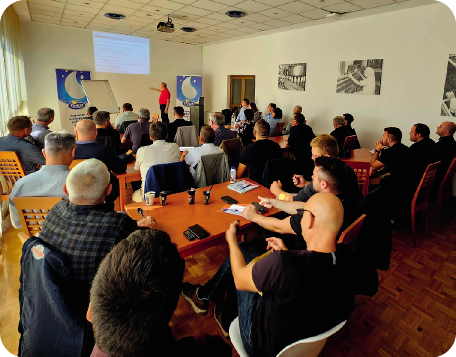
-
4. Offering healthy, tasty and accessible products
-
4.1Making food quality and safety an absolute priority
Definition
- •producing and distributing products that comply with applicable international and local regulations and standards;
- •striving for excellence without ever compromising on the safety, compliance, and quality of its products and services in all the countries in which it operates.
-
4.2Promoting a healthy and balanced diet
Definition
Since its beginning in Laval in 1933, Lactalis has been driven by a passion for Dairy products and the deep conviction that they belong to a healthy and balanced diet. Lactalis also believes that pleasure is a fundamental driver of maintaining a balanced diet in the long term.
Eating well starts with choosing quality products and ingredients that people enjoy cooking and sharing. Lactalis is committed to combining taste and nutritional requirements in the development of its recipes. Lactalis' teams constantly seek the right balance between the taste, simplicity, and nutritional composition of products, particularly in terms of fat, sugar, and salt.
Lactalis believes that a balanced diet should not only avoid fatty acids, sugar, or salt, but also cover the need for essential nutrients, while taking into account the place, role, and nature of each food and ingredient in dietary recommendations. Thus, the portion and frequency of consumption of each food or ingredient play a determining role in dietary balance, because it is the final nutritional composition of the plate that counts and fully justifies the place of dairy products and fats in the diet.
Lactalis considers that education in good eating habits is crucial to achieve a balanced diet. As such, the Group’s brands make consumers aware of the importance of eating a balanced and varied diet through regular meals, ideally shared with the family, as numerous studies have demonstrated the positive impact of such practices.
-
5. Protecting the planet and its resources
-
5.1Industrial environmental strategy
Definition
As a world leader in dairy products, Lactalis intends to fulfill its mission to contribute to healthy and tasty food while preserving natural resources and biodiversity for future generations. In accordance with its corporate culture and model, the Group bases the environmental strategy of its industrial operations on a local approach, based on the principle that local solutions are the most appropriate to meet direct environmental challenges. To structure these approaches in dialogue with its stakeholders, and to respond to the diversity of profiles, cultures, and industrial histories of its sites, the Group shares guiding principles and methods.
-
5.2Fighting climate change
5.2.1General approach
Definition
Climate action and Lactalis’ adaptation of its activities to this new paradigm have been identified as a priority of its CSR strategy.
The food and beverage sector, along with its upstream agricultural component, is considered a key player when it comes to bringing positive solutions to cut greenhouse gas emissions (GHG) and increase the resilience of production systems throughout the value chain. As one of the world's leading agrifood companies and a leader in the dairy sector, Lactalis intends to use its size as a lever for climate action: identifying partners and solutions that have proven their worth locally and helping them expand internationally to accelerate the transition to less carbon-intensive production models.
Governance
In order to achieve the ambitions of its Climate roadmap, Lactalis has set up a Climate Committee, made up of internal experts from the main Departments affected by the issue (Industry, Transport and Logistics, Milk Supply, Purchasing, Equipment, and CSR). This work also implies regular interactions with a network of Lactalis internal experts based in the countries in which it operates. This Committee proposes strategies and action plans, as well as procedures, methodologies, and tools for their successful implementation.
The Committee's proposals are submitted to a Strategic Climate Committee composed of Department Directors and Managers, as well as members of the Lactalis Group Management Committee. These are then presented, discussed, and approved by the Group's Management Committee and CEO.
The Group CSR team is responsible for coordinating the Group's climate reporting, calculating the Group's GHG emissions, and ensuring, in close collaboration with the relevant internal experts at Group level, that the roadmaps of the various countries and business units are aligned with the Company's climate commitments.
Policy
The SCIENCE-BASED TARGETS INITIATIVE VALIDATES LACTALIS CLIMATE ROADMAP
Created in 2015, the Science-Based Targets initiative (SBTi) encourages companies to set science-based greenhouse gas emission reduction targets to fight climate change effectively.
In 2022, Lactalis signed a letter of commitment to align its greenhouse gas emission reduction roadmap with the recommendations of the Science-Based Targets initiative (SBTi). The framework set by the SBTi complies with the scientific recommendations of the Paris Agreement to limit the increase in global temperatures to +1.5°C compared to pre-industrial levels.
In July 2024, the SBTi officially validated Lactalis’ GHG reduction targets, contributing to the international recognition of the Group's approach.
In order to achieve its Net Zero ambition by 2050, the Group is committed to the following targets:
- 1.reduce greenhouse gas emissions from the Group's activities (scopes 1 and 2):
- •reduce the Group’s absolute scope 1 and 2 GHG emissions by 46.2% by 2030 (from a 2019 base year);
- 2.lead the way in terms of decarbonization across the group's value chain (scope 3):
- 3.no deforestation across the Group’s entire value chain by the end of 2025.
These intermediate targets will help guide Lactalis' progress towards the target of net-zero emissions, thus enabling it to contribute to achieving carbon neutrality on a global scale. They will also make it possible to initiate actions now aimed at achieving the long-term roadmap. Combined, these actions will also boost the company's climate resilience.
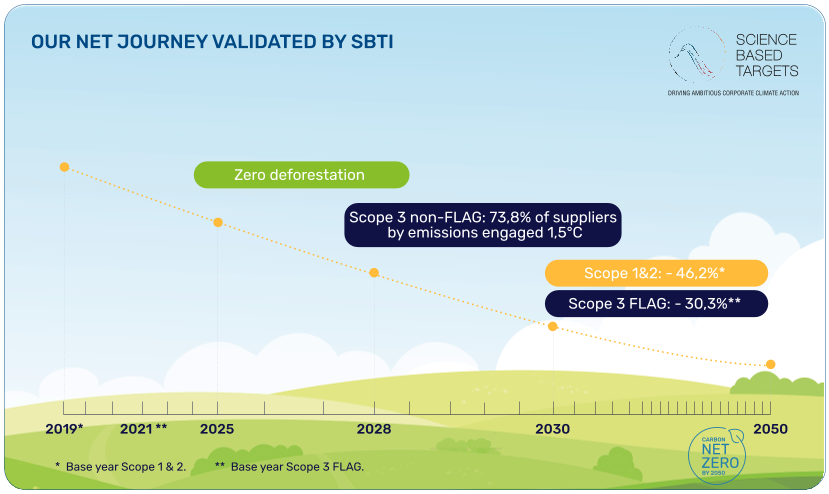
Action plan
Lactalis measures its greenhouse gas emissions using the GHG Protocol method. This assessment concerns the entire Group. The Group's greenhouse gas emissions break down as follows:
With 94% of the Group's greenhouse gas emissions, Scope 3 is the company's most important item. Within this Scope 3, the so-called FLAG emissions are the most significant (82% of the Group's carbon footprint) and approximately 95% come from the Group's milk supply production (i.e., the production of milk by partnering farmers of Lactalis upstream of its activities).
Scope 3 non-FLAG emissions account for around 12% of the Group's carbon footprint, mainly broken down into the following emissions categories:
- •purchases of goods and services, which account for 43% of the Group's Scope 3 non-FLAG emissions;
- •capital goods, which represent nearly 18%;
- •transport and distribution upstream of the value chain, which account for approximately 14%;
- •activities related to fuel and energy, which account for 11%.
Lactalis focuses primarily on measuring its emissions from its industrial and logistics activities in scopes 1 and 2 in its largest subsidiaries (see 7. / Methodological note). As such, the Group's various entities have access to their emissions reports for scopes 1 and 2, and use these figures to build their climate roadmap in order to implement the Group's commitments on a local scale. Then, in 2023, the Group adopted a similar approach for its Scope 3 FLAG emissions. Lactalis is now continuing this work of specifying the measurement of its emissions on the rest of the value chain (Scope 3 non-FLAG), in order to enable the Group's various entities to have access to their local carbon footprint in the short term (Scopes 1, 2, and 3 combined).
All relevant teams and internal experts have been brought on board to achieve these climate objectives. The main countries and divisions establish roadmaps in collaboration with the central expert departments, taking into account their local context and opportunities. These roadmaps are then regularly reviewed and improved.
Through its Research and Development activities, and the partnerships forged with experts such as universities, the Group anticipates new regulations, new technologies in the fields of livestock feed, storage and cooling technologies for milk, innovative packaging, etc. These efforts enable the Group to better meet the expectations of its stakeholders, and in particular its customers and consumers.
As such, Lactalis has been supporting the Pathways to Dairy Net Zero initiative for three years. This initiative brings together dairy farms of all sizes and types, as well as organizations from across the dairy supply chain. Launched in September 2021 during Climate Week, this growing movement is dedicated to reducing greenhouse gas emissions from dairy products over the next 30 years.
In addition to the Group, Lactalis' international subsidiaries are also involved in climate initiatives to accelerate the response to climate change. This is the case for Lactalis USA, which joined the Dairy Methane Action Alliance (DMAA) at the end of 2023. This coalition, launched during COP 28, aims to stimulate actions to reduce methane emissions from the dairy sector. To help them in this process, signatories receive technical assistance from the Environmental Defense Fund and other non-industrial partners via the coalition. The DMAA also aims to serve as more of a collective voice vis-à-vis policymakers, investors, and standards bodies to develop frameworks and practices that better support action on methane. In this context, in 2024, Lactalis USA measured and published the results of its 2023 methane emissions linked to its upstream dairy sector. The reduction plan associated with these emissions has also been drawn up, with a view to its publication in 2025. Lastly, Lactalis USA took part in workshops organized throughout the year by the DMAA, on topics such as technical solutions to reduce methane emissions, their financing, and their planning.
Results
The Group monitors the evolution of its emissions for Scopes 1 and 2 (presented in accordance with the market-based method), in line with its SBTI targets:
2023*
2024
Scope 1 greenhouse gas emissions from industrial sites,
warehouses, and vehicle fleet (tCO2eq)1,378,045
1,350,567
Scope 1 biogenic emissions from industrial sites,
warehouses, and vehicle fleet (tCO2eq)356,798
346,880
Scope 2 greenhouse gas emissions from industrial sites,
warehouses, and vehicle fleet (tCO2eq)576,739
572,014
- *The emissions for 2023 have been recalculated on the same reporting scope as those of 2024 in order to be comparable (see methodological note).
- 1.reduce greenhouse gas emissions from the Group's activities (scopes 1 and 2):
-
5.3Fighting against deforestation
Definition
Forest is an essential ecosystem that offers a multitude of environmental, economic, and societal services. This ecosystem helps to maintain biodiversity, regulate the climate, and produce clean air. It is an essential agent for water and soil purification, as well as for the retention and replenishment of water resources. Currently, forests are disappearing and degrading at an alarming rate across the globe.
Depending on the region, multiple factors cause deforestation. However, agriculture remains the main driver of deforestation on a global scale. Almost 40% of deforestation in the world is linked to agricultural production, in particular the cultivation of soybeans, palm oil, cocoa, coffee, wood-based products, and cattle farming.
-
5.4Reducing the water footprint of the group's products
Definition
From the production of milk on farms to the downstream management of industrial effluents, including on-site cleaning activities, water management is a strategic focus for Lactalis. The preservation of resources in terms of quantity and quality aims to guarantee business continuity, the quality and safety of the food produced, as well as respect for the needs of local communities and the protection of ecosystems. The impact of climate change requires a specific approach for facilities under significant water stress.
-
5.5Promoting the circular economy
5.5.1Improving packaging solutions
Definition
Dairy products are fragile by nature. Packaging has essential functionalities, such as preserving the nutritional quality and taste of products, food safety, as well as the convenience of use for consumers.
However, packaging can represent a major source of waste. The ways we produce and dispose of packaging can also result in the overconsumption of our planet’s scarce natural resources, threatening the environment and biodiversity.
Consequently, in all its geographical areas of operation, Lactalis engages in dialogue with its stakeholders in order to raise awareness and promote innovative solutions for a circular economy for packaging.
Governance
The Group’s Packaging Policy is designed, monitored, and adapted by the Responsible Packaging & Circular Economy Committee. It is composed of internal experts from the most affected departments: R&D, Purchasing, Marketing, Regulatory, and CSR. This work involves regular interactions with a network of internal experts based at the Group's production sites. This Committee proposes strategies and action plans, as well as procedures, methodologies, and tools for their successful implementation.
The Committee's proposals are submitted to a Responsible Packaging & Circular Economy Strategic Committee composed of Directors or Managers of Departments, as well as members of the Group's Management Committee. They are then proposed, discussed, and approved by Lactalis' Group Management Committee.
In the countries, the implementation of packaging innovation or renovation projects is led by local working groups responsible for verifying the technical and economic feasibility and implementing the changes. These projects are subject to approval by the Senior Management of each division.
Policy
The Group's Packaging Policy aims to continue to offer quality products to consumers through innovation and continuous improvement to find the “Right Packaging”. At each stage of the development and use of packaging, and wherever possible in the supply chain, the company's main objective is to ensure better circularity.
In its efforts to “close the loop,” Lactalis has broadened its approach by engaging with all stakeholders through awareness-raising action and partnerships. This approach also makes it possible to better anticipate future regulations.
- 1.the “Right Packaging”: the group seeks the appropriate balance between its desire to reduce packaging and the need to guarantee the preservation, quality, and practicality of products when designing packaging;
- 2.improved circularity: Lactalis ensures that its packaging is made from safe and sustainable materials, so that it forms part of a circularity approach. The company, therefore, gives priority to the right intensity by removing obstacles to the circularity of packaging and incorporating more recycled materials.
- 3.raising consumer awareness and creating partnerships to close the loop: Lactalis makes its internal and external stakeholders aware of the collective challenge of circularity.
As part of its Packaging Policy, Lactalis has made the following commitments(12):
- •100% of current and future packaging solutions for our pillar products and packaging for product innovations will be analyzed using an eco-design tool by 2025;
- •at least 30% recycled materials in our packaging;
- •ensure the recyclability of the Group's product packaging through two ambitions:
- –aim to 100% recyclable packaging by design by 2025,
- –aim to 100% recyclable in practice in 2033 for countries with an Extended Producer Responsibility (EPR) system;
- •100% virgin paper covered by a sustainable certification by the end of 2023;
- •aim to eliminate PVC from the Group's product packaging by 2025;
- •100% of the new packaging graphics for Lactalis' brands to carry information on waste management from 2022, and 100% of packaging to carry information on waste management by 2025;
- •set up an information module on Lactalis' Packaging Policy to raise employee awareness;
- •promote events such as Global Recycling Day and World Cleanup Day to raise awareness among group employees and stakeholders about waste management.
Action plan
The “Right Packaging”
The Group screens the various packaging options using an eco-design tool to develop and select the “Right Packaging”.
Lactalis reduces all unnecessary packaging components that do not contribute to consumer comfort or logistics, and minimizes packaging intensity by reducing the packaging materials used per product.
- •in France, the elimination of plastic lids on cheese trays saved 71 metric tons of plastic in 2024;
- •in the Czech Republic, the reduction in the weight of cardboard boxes used to transport mozzarella-type cheeses made it possible to use 200 kg less cardboard in 2024;
- •in Canada, the weight of drinkable yogurt bottles has been reduced, saving 147 metric tons of plastic in 2024.
Better circularity
In order to promote circularity, the teams select packaging materials by analyzing their production methods, their transformation, and their certifications.
Lactalis seeks to avoid packaging materials that disrupt local sorting and recycling channels, and is developing the use of recycled materials in its packaging. The company aims to guarantee the recyclability of packaging wherever it is sold and to increase the proportion of packaging effectively recycled “in practice” in accordance with existing local programs.
- •in the United States, the change to mono-material packaging for some baby pouches, coupled with the lighter cap, has increased recyclability and reduced the weight of packaging placed on the market by 24 metric tons per year.
- •in Italy, the change of material for a mozzarella-type cheese packaging made it possible to obtain 15 metric tons of recyclable packaging per year.
Educating consumers and partnering to close the loop
Lactalis engages in dialogue with consumers by offering clear and innovative sorting instructions for its products.
- •In France, a "yellow top" operation on milk bottles is helping to raise consumer awareness about sorting their bottles into the correct bin (the sorting bin in France is also yellow).
The Group is also involved in local collective projects and platforms to develop sorting and recycling channels through three consortia in France:
- •the PS25 consortium, made up of several companies in the dairy sector. This consortium has enabled the creation of a polystyrene (PS) recycling channel, and Lactalis continues to participate in its development, in particular through a campaign to encourage trash sorting;
- •the FLEX 25 consortium, made up of several companies in the agri-food sector. It aims to develop recycling solutions for flexible PE, PP, and PO packaging by 2025 and to return to food packaging that meets traceability requirements by 2030;
- •the PET 25 consortium, which unites several agri-food companies around the objective of encouraging the development of new rigid, sealed or unsealed packaging technologies. A study phase is underway for the creation of an industrial sector for the recycling of PET household packaging by 2025.
In Italy, Lactalis participated in the project to develop a recycling channel for opaque white PET, which allows the integration of recycled materials into its new milk bottles. The subsidiary is now operational, and the Group uses the material from this sector to manufacture new milk bottles (integration of 50% opaque white rPET).
INTERNATIONAL MOBILIZATION AT WORLD CLEANUP DAY 2024
Through its Packaging policy, Lactalis is committed to raising employee awareness of the collective challenge of circularity. Since 2020, Lactalis has invited its employees to participate in the “World CleanUp Day”, launched by the NGO “Let's do it! ".
In 2024, the operation was a great success with the participation of new countries such as Mexico, Chile, Moldova, Kazakhstan, Uzbekistan, and North Macedonia.
In total, 2,855 employees and their families in 38 countries took part and collected 38 metric tons of waste. In France, this event also raised employee awareness of waste through workshops led by internal experts and visits to sorting centers.
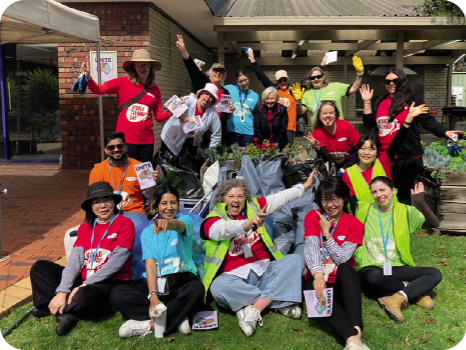
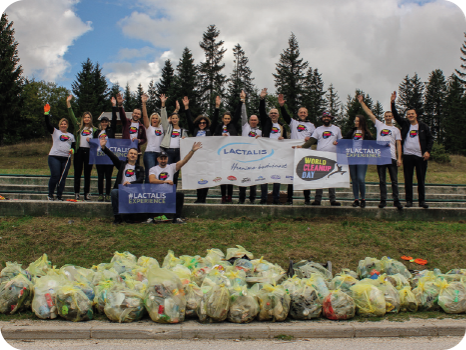

Results
-
5.6Caring for animals all along our value chain
Definition
As the world’s leading dairy group, Lactalis pays special attention to all the animals in its supply chain, in particular to the approximately five million dairy animals (cows, buffalos, sheep and goats) producing the milk the group processes daily.
Lactalis fully recognises and respects them as sentient beings, capable of feeling emotions, that deserve both physical and mental health: contributing to their welfare is a responsibility for Lactalis.
Moreover, animal welfare is a cornerstone for the sustainability of the group’s activities. Indeed, there is a close link between animal welfare and milk production. For example, a cow needs sufficient access to food and water, sufficient bedding space, good hygiene, etc. to produce high quality milk. Therefore, ensuring animal welfare is part of the daily work of the employees managing Lactalis milk supply, as well as that of the group’s partnering farmers.
-
6.Vigilance plan 2024
-
6.1Introduction
Created in 1933 by André Besnier in Laval, Lactalis has been a family business for three generations. Lactalis has been developing dairy and cheese know-how since the company was founded, strengthening this expertise as it has grown. It offers consumers a wide range of dairy products in all categories: cheeses, fluid milk, yogurts, chilled dairy products, butter and cream, powdered formula and milk for infants and adults, clinical nutrition products, and dairy ingredients.
-
6.2Governance
The vigilance plan is defined and coordinated by a working group in charge of vigilance, comprising the CSR, Quality, and Crisis Management Department and the Legal Affairs and Audit Department (including the Compliance & Competition Service). Lactalis works on vigilance in collaboration with various company departments, including Group Purchasing, Milk Supply, Energy & Environment, Health & Safety, Food Quality & Safety, and Human Resources, among others.
- •the central functions, such as the Health & Safety Department, the Energy & Environment Department, the Human Resources Department, the Food Quality & Safety Department, and the Milk Supply Department, as well as the Group Purchasing Department, are, with the CSR team and Compliance and Competition team, responsible for:
- –the mapping of risks related to human rights, Health and Safety, and the environment,
- –the definition of due diligence and risk assessment actions,
- –monitoring vigilance in their activities;
- •the countries and divisions oversee the roll-out of the vigilance plan at the local level.
- •the central functions, such as the Health & Safety Department, the Energy & Environment Department, the Human Resources Department, the Food Quality & Safety Department, and the Milk Supply Department, as well as the Group Purchasing Department, are, with the CSR team and Compliance and Competition team, responsible for:
-
6.4Stakeholder engagement
Lactalis is committed to collectively preparing the future of the dairy sector and its supply chains, in a spirit of co-construction and dialogue with stakeholders.
In most of the countries where Lactalis operates, the company is a member of various federations, professional organizations, and consultancy bodies (e.g., ANIA - French national association of food Industries, ATLA - Association de la transformation laitière française, EDA - European Dairy Association, IDF - International Dairy Federation), aiming to develop demanding, qualitative, and sustainable production standards.
-
6.5mapping of risks related to human rights, Health and Safety, and the environment
6.5.1Identification and prioritization of CSR risks
Lactalis has identified the risks related to human rights and fundamental freedoms, the Health and Safety of people, and the environment in the course of its activities.
- •international standards and guidelines (GRI, ISO 26000);
- •a study of CSR matters in the food and dairy sector;
- •the expectations expressed in the CSR questionnaires received by Lactalis;
- •the materiality analysis conducted in 2020: Lactalis carried out a vast consultation campaign with more than 175 internal and external stakeholders in 14 of its largest countries to obtain their views on the main impacts of the Group’s activities (see section 2.4 / Main CSR challenges and risks).
Following the materiality analysis, a prioritization of the issues according to the group’s impact and maturity levels was prepared internally, which made it possible to define the priority issues.
The CSR risks related to the priority issues that could impact human rights and fundamental freedoms, the Health and Safety of people, and the environment are as follows:
Priority issue
Identification of risks related to human rights, health & safety, and the environment.
Health & Safety
The Health and Safety of employees is recognized as a human right
and is also part of the UN Sustainable Development Goals.Negligence on the part of the company in terms of health & safety support at work could result in occupational injuries or diseases for employees or external workers.
Human resources
and social issuesIn the Group’s own activities, non-compliance with the Group’s Human Resources policies could lead to situations of discrimination or non-respect of freedom of association.
Through their supplies, players in the value chains of certain raw materials could resort to practices that violate human rights.
Food safety
Any breach of food safety can present serious health risks to consumers.
At each stage of product production, failure to comply with hygiene standards or product health controls can have serious impacts on consumers.
Water, energy,
and GHG emissions (Scopes 1, 2, and 3)The Group’s activities may give rise to environmental risks, notably related to the use of water and energy.
Failure to address environmental issues related to water, energy, and greenhouse gas emissions could therefore present a risk to the preservation of resources and the necessary mitigation of global warming.
Responsible packaging and circular economy
Packaging is fundamental for preserving the strictest food quality and safety standards for dairy products, which are fragile by nature. The ways we produce and dispose of packaging result in the over-consumption of natural resources, threatening the environment and biodiversity.
Biodiversity and forests
The Group’s supplies of agricultural raw materials may be directly or indirectly linked to a risk of deforestation or the conversion of natural areas, having an unfavorable impact on biodiversity and ecosystems.
Safety and sustainability of upstream milk production methods
Milk is the key raw material for Lactalis’ activities. While the safety of milk is a key factor in guaranteeing product quality and safety, the Group’s consumers and stakeholders are increasingly looking for guarantees of the sustainability of upstream processes. This focus is on practices that are more respectful of animal welfare and the environment. Lactalis can meet both market expectations and those of its stakeholders by developing technical advice for dairy farmers.
Poor upstream dairy practices could have negative consequences on animal welfare, the environment, and consumer health and safety. They could also affect the company's reputation and results.
-
6.6Regular assessment measures
6.6.1CSR assessment measures for the Group and its subsidiaries
Annual Group CSR reporting is carried out, and audits are conducted each year by an independent third party to verify the fairness and reliability of the Group’s consolidated data.
The KPIs related to the Group’s vigilance plan are listed in section 6.10.1 / Summary of vigilance indicators.
-
6.7Mitigating risks and preventing serious harm
Lactalis is a signatory of the United Nations Global Compact. Lactalis respects and promotes these 10 principles.
Lactalis has established policies and processes to exercise its duty of care in all its activities. These policies and processes define the Group's guidelines for the prevention of serious risks to human rights, Health & Safety, and the environment.
6.7.1Measures to mitigate and prevent social risks
Rules of procedure
In France, the rules of procedure establish the rules on Health & Safety and disciplinary measures and reiterate the legal provisions covering sexual harassment and the prevention of sexism. The rules of procedure are displayed at all sites in France.
Social dialogue
Lactalis encourages continuous, simple, and close dialogue with employees and union representatives. To contribute to the quality of social relations within all Group entities, Lactalis has developed an internal training course on its approach to social dialogue, the “Lactalis Labor and Employees Relations Way,” currently being rolled out to local Human Resources Managers.
The group’s subsidiaries are invited to set up social dialogue bodies in compliance with local regulations. In addition, a European Social Dialogue Body was set up in 2019 and represents 16 of the group’s countries. The aim of this body is to share quantitative information on Lactalis, the levels of activity in each product universe, and the group’s medium- and long-term strategic areas of development.
In addition, Lactalis is working on a social risk assessment project that aims to improve social dialogue through weekly site visits and on-site meetings. Since 2022, this method has been rolled out on 30 sites and warehouses located in 10 countries. The method will continue to be rolled out in 2025.
Promoting diversity
In June 2024, the Group’s Diversity, Equity, and Inclusion policy, established by the Group’s Human Resources Department, was officially rolled out. This policy is based on two pillars (gender equality and inclusion) and eight concrete commitments for which the Group Human Resources Department is responsible for defining and proposing concrete actions:
- 1.the integration, development, and promotion of diverse talents;
- 2.the equity of human resources management processes, in particular recruitment, retention, promotion, compensation, and access to training;
- 3.promoting inclusive behaviors through team training and awareness-raising;
- 4.diversity at all hierarchical levels;
- 5.measuring the perception of Diversity, Equity, and Inclusion through engagement surveys;
- 6.facilitating and coordinating the approach via a network of Diversity, Equity, and Inclusion ambassadors;
- 7.progress indicators;
- 8.communication of this approach to the Group’s stakeholders.
Lactalis aims to train 100% of its employees in Diversity, Equity, and Inclusion from 2024 onwards. To this end, a digital training challenge on Diversity, Equity, and Inclusion was rolled out worldwide in 2024. Composed of a first module explaining Lactalis' Diversity, Equity, and Inclusion Policy, and five thematic modules on inclusive leadership, gender equality, cultures and origins, intergenerational skills, and disability, this challenge enabled large-scale training of employees on the issues of Diversity, Equity, and Inclusion.
In addition, Lactalis has been measuring the perception of diversity, equity, and inclusion using managerial surveys since 2023.
An awareness-raising workshop for internal teams was developed by the central HR teams: Lactalis DE&I experience.
In the subsidiaries, several initiatives to promote diversity have already been implemented, such as in Canada, Sweden, South Africa, Slovenia, and Brazil, where diversity policies are being deployed.
Gender equality
Lactalis’ objective is to strive for a balance in management positions by 2033. A key performance indicator on the proportion of women in leadership positions is monitored.
An online reporting platform in the event of non-compliance with non-discrimination laws and regulations is accessible to all.
Youth training and employment
Lactalis works to promote the employment of young people and develops partnerships with training institutions.
Lactalis provides special support to its younger employees through training and work-study programs.
For instance, in France, since 2002, as part of the I2FA program in partnership with the École Supérieure des Agricultures (ESA), foreign students from 36 different countries follow a work-study program for two years, which enables them to access positions of responsibility within Lactalis' local teams.
In 2021, Lactalis set up a Lactalis Apprenticeship Training Center (CFA) focused on the dairy industry.
Disability
Lactalis invests in the reception, integration, and job retention of employees with disabilities. Policies and action plans are adapted at a national level.
In France, for example, Lactalis has had a Disability agreement in place since 2010 and is working on the following issues:
- •preserving jobs and hiring people with disabilities;
- •adapting workstations and providing assistance via individual devices (hearing aids, adapted shoes, ergonomic seats);
- •raising awareness and training: the group’s production sites organize awareness-raising actions for all over several days to combat disability-related prejudices;
- •working with adapted establishments that welcome workers with disabilities;
- •individual support measures: reduced working hours, return to work assistance, etc.
Other initiatives are rolled out by the Group’s subsidiaries in the countries in which they operate (see section 3.2.3 / Promoting diversity).
Social security coverage
Lactalis has drawn up guidelines enabling its subsidiaries to implement local health and life insurance, and retirement measures.
Well-being at work
Lactalis is developing a global and local approach to well-being at work in order to ensure that the pillars of the national well-being at work policy are consistent with the expectations of its local employees and the cultural sensitivities in the various countries in which it operates.
Lactalis is also in favor of sharing or even replicating certain social innovations that have proven successful in one or more countries.
In France, Lactalis has a national agreement on well-being at work: each operational division must define its own well-being at work policy in accordance with the framework set out in the agreement. Best practices implemented in the divisions are shared and recognized through awards. The human resources teams ensure that the well-being at work policy is in line with the employee expectations at a local level. In France, some employee representatives of the Health and Safety Commission (within the Social and Economic Committee) are trained as psychological risk officers.
Inspired by the well-being at work approach in France, an international Well-being at Work approach was rolled out in 2024 through six themes:
- •working safely and protecting well-being (physical and mental);
- •being in an environment conducive to quality work;
- •optimized organization of work: working hours planned to ensure a good work/life balance;
- •finding a source of motivation at one’s work;
- •developing skills and progressing within the company: ensuring employability and the ability to develop;
- •living together at work: managerial relations and those between colleagues.
-
6.8Whistleblowing system
The Lactalis reporting platform (“Lact@lert”) enables employees and external stakeholders to report any situation that is against the law through a secure platform: violation of human rights, fundamental freedoms, occupational Health and Safety, the environment, food safety, and hygiene rules, among others.
-
6.9Monitoring measures and assessing their efficacy
As stated previously, Lactalis has set up a dedicated reporting and monitoring process for the various vigilance-related issues.
The Group’s CSR Department maintains a CSR dashboard that details the sustainability performance of the operating divisions using KPIs on three priority topics for Lactalis (climate, animal welfare, packaging), as well as palm oil. The CSR dashboard also assesses the construction and alignment of national roadmaps with the group’s objectives. It is presented every year to the Group’s Management Committee.
In addition to the CSR dashboard, Lactalis monitors KPIs to assess the effectiveness of the measures. These KPIs are presented to the Strategic Committee in charge of vigilance and are also included in the vigilance plan report.
Thanks to the governance in place (see Section 6.2 / Governance), the Strategic Vigilance Committee will monitor the effectiveness of actions and may request adjustments if necessary.
-
6.10Report on the 2024 vigilance plan
6.10.1Summary of vigilance indicators
Lactalis has set up a dedicated reporting and monitoring process for the various issues related to its duty of care. The central Departments carry out awareness-raising and support work with the group’s various subsidiaries to ensure that vigilance measures are understood, applied, and monitored throughout Lactalis.
Below are the indicators for 2024 relating to risks identified by Lactalis in the context of the implementation of the vigilance plan in the Group’s activities and with regard to its suppliers:
Issue
Indicators*
2023
2024
Health and Safety within the Group’s activities
Number of personal Health and Safety audits carried out
9
4
Social issues within the Group’s activities
Percentage of women in leadership positions
28.2%
27.7%
Percentage of target Human Resources
teams trained in the Social Dialogue Model67.0%
70.5%
Food safety
and qualityNumber of Group Quality audits
103
84
Number of advisory visits
62
118
Percentage of industrial activities certified according to at least
1 of the 5 ISO 22000, FSSC 22000, IFS, BRC, SQF certificates85%
88%
Issues related
to suppliers and subcontractorsPercentage of purchased volumes of palm oil
and derivatives covered by sustainable certification87%
92%
Number of suppliers audited by the Lactalis Supplier Audit team
343
333
Number of subcontractors audited by the Lactalis Supplier Audit team
160
112
Animal welfare
Percentage of direct annual volume of collected raw milk in the 11 pilot countries coming from partnering farms regularly assessed on animal welfare, according to the Lactalis internal assessment method or an ambitious national standard (at least once every 3 years)
61%
75%
Percentage of direct annual volume of collected raw milk in the 10 additional countries coming from partnering farms regularly assessed on animal welfare, according to the Lactalis internal assessment method or an ambitious national standard (at least once every 3 years)
45%
60%
Percentage of indirect annual volume of collected raw milk in the 21 countries coming from partnering farms regularly assessed on animal welfare, according to the Lactalis internal assessment method or an ambitious national standard (at least once every 3 years)
59%
61%
Percentage of annual volume of purchased
shell eggs worldwide coming from cage-free systems100%
100%
Percentage of annual volume of purchased
egg products worldwide coming from cage-free systems91.85%
92.06%
Packaging
circularityPercentage of volumes of virgin cardboard
covered by a sustainable certification89.8%
95.9%
Percentage of recycled material in our packaging
31.3%
32.3%
Metric tons of PVC in our packaging
616
866
Percentage of packaging recyclable by design
83.8%
82.8%
Environmental issues within the group’s activities
Number of internal environmental site audits carried out
57
68
- *See the methodological note for comments regarding the scope of the indicators.
-
7.Methodological note
-
7.1Organization of CSR reporting
- •the central technical services (Purchasing, Quality, Milk Supply, Energy and Environment, Supply Chain, Human Resources, Health & Safety, Nutritional Marketing and Compliance);
- •CSR referents in the group’s various entities, who are responsible for distributing CSR reporting instructions and sharing the best country practices.
-
7.2Time and geographical scope of reporting
The data used to calculate the various indicators covers the period from January 1, 2024, to December 31, 2024.
Theme
KPI
Scope covered in 2024
Coverage
rate 2024QUALITY
Percentage of industrial activities certified according to at least 1 of the 5 ISO 22000, FSSC 22000, IFS, BRC, SQF certificates
Group scope excluding Russia, sites producing animal feed, inter-sites, collection sites, and refining cellars (without production site)
99% of Group revenue
SOCIAL/HR
Percentage of leadership positions recruited through internal promotion
Group scope
100% of the Group’s workforce
Engagement rate (according to the managerial survey)
Group scope excluding Russia and Belarus: managerial survey waves of 2023 and 2024
97.3% of the Group’s workforce
Resignation rate
Group excluding the following entities:
- •Nutrition Asia;
- •R&D except France;
- •Hawkridge UK
99.9% of the Group’s workforce
Percentage of target Human Resources teams trained in the Group’s Social Dialogue Model
Group excluding the following entities:
- •Nutrition Asia;
- •R&D except France;
- •Hawkridge UK.
99.9% of the Group’s workforce
Percentage of women in leadership positions
Group excluding the following entities:
- •Nutrition Asia;
- •R&D except France;
- •Hawkridge UK.
99.9% of the Group’s workforce
ANIMAL WELFARE
(raw milk from cows)
Percentage of direct annual volume of collected raw milk in the 11 pilot countries coming from partnering farms regularly assessed on animal welfare, according to the Lactalis internal assessment method or an ambitious national standard (at least once every 3 years)
Australia, Belgium, Brazil, Canada, France, Germany, Italy (excluding the Ambrosi business unit acquired in 2023), Spain, Sweden, the United Kingdom, and the United States of America (Lactalis American Group and Lactalis US Yogurt subsidiaries).
89% of the total volume of raw cow's milk collected by Lactalis worldwide
Percentage of direct annual volume of collected raw milk in the 10 additional countries coming from partnering farms regularly assessed on animal welfare, according to the Lactalis internal assessment method or an ambitious national standard (at least once every 3 years)
Croatia, Czech Republic, the Netherlands, Poland, Portugal, Romania, Slovenia, South Africa, Switzerland, and Turkey.
Percentage of indirect annual volume of collected raw milk in the 21 countries coming from partnering farms regularly assessed on animal welfare, according to the Lactalis internal assessment method or an ambitious national standard (at least once every 3 years)
Australia, Belgium, Brazil, Canada, France, Germany, Italy (excluding the Ambrosi business unit acquired in 2023), Spain, Sweden, the United Kingdom and the United States of America (Lactalis American Group and Lactalis US Yogurt subsidiaries), Croatia, Czech Republic, the Netherlands, Poland, Portugal, Romania, Slovenia, South Africa, Switzerland, and Turkey
ANIMAL WELFARE
(Shell eggs
and egg products
from laying hens)Percentage of annual volume of purchased shell eggs in the EU coming from cage-free systems
All Group activities in the European Union, excluding R&D volumes.
100% of the total volumes of shell eggs and egg products purchased by the Group in the European Union (excluding R&D volumes)
Percentage of annual volume of purchased egg products in the EU coming from cage-free systems
Percentage of annual volume of purchased shell eggs worldwide coming from cage-free systems
Group scope, excluding Russia and the Marie-Morin Canada business unit acquired in 2023, excluding R&D volumes.
94% of the total volumes of shell eggs and egg products purchased by the group worldwide (excluding R&D volumes)
Percentage of annual volume of purchased egg products worldwide coming from cage-free systems
ENERGY/CLIMATE
Energy consumption (kWh LHV/kg finished products)
This KPI concerns the industrial sites and warehouses linked to these sites (excluding independent warehouses outside France) as well as, for France, offices, and independent warehouses.
France, Canada, Brazil, Spain, Italy, the United States, Australia, South Africa, Turkey, Germany, India, Croatia, Romania, Sweden, Slovenia, Poland, Czech Republic, Belgium, Portugal, United Kingdom, Switzerland, Serbia, Bosnia, Hungary, Macedonia, Greece, Netherlands, Luxembourg
89.6% of the Group's production volume
Scope 1 GHG emissions from industrial sites, warehouses, and vehicle fleet (tCO2eq)
Scope 1 biogenic emissions from industrial sites, warehouses, and vehicle fleet (tCO2eq)
Scope 2 GHG emissions from industrial sites, warehouses, and vehicle fleet (tCO2eq)
ENVIRONMENT
Number of environmental trainings provided in France
France
100% of the France production volume
Percentage of production sites ISO 14001 certified among IED sites
These KPIs concern the industrial sites and warehouses linked to these sites (excluding independent warehouses outside France) as well as, for France, offices, and independent warehouses, for the following countries:
France, Canada, Brazil, Spain, Italy, the United States, Australia, South Africa, Turkey, Germany, India, Croatia, Romania, Sweden, Slovenia, Poland, Czech Republic, Belgium, Portugal, United Kingdom, Switzerland, Serbia, Bosnia, Hungary, Macedonia, Greece, Netherlands, Luxembourg
89.6% of the Group's production volume
Water withdrawal (L/kg finished products)
Wastewater discharge (L/kg finished products)
RESPONSIBLE PACKAGING AND CIRCULAR ECONOMY
Percentage of volumes of virgin cardboard covered by a sustainable certification
France, Canada, Italy, USA, Brazil, Spain, Australia, Turkey, Germany, Sweden, the UK, South Africa, Romania, Poland, Switzerland, Belgium, Croatia, Portugal, the Netherlands, the Czech Republic, Slovenia
85% of Group revenue
Percentage of recycled material in our packaging
Metric tons of PVC in our packaging
Percentage of packaging recyclable by design
FORESTS AND BIODIVERSITY
Percentage of purchased volumes of palm oil and derivatives covered by sustainable certification
Group scope
100% of Group revenue
HEALTH & SAFETY
Frequency rate of workplace accidents with employee lost time (Employee FR1)
Group scope
100% of the Group's workforce
Workplace accidents with and without lost time frequency rate for employees and temporary workers (FR2)
Severity rate for employees
NUTRITION
Percentage of volumes of products subject to internal recommendations for total sugars (flavored and ultra-fresh milk categories: yogurts, desserts, gourmet desserts) compliant vs. total volume of recommended products taken into account
France (Mainland & DOM TOM), Canada, Italy, USA, Brazil, Spain, Australia, Germany, Sweden, the UK, South Africa, Romania, Poland, Switzerland, Benelux, Croatia, Portugal, Czech Republic, India, Turkey, Luxembourg, the Netherlands, Saudi Arabia, Slovenia, Kazakhstan
89% of Group-brand revenue (excluding infant & specialized nutrition and B2B ingredients)
Percentage of processed cheese volumes subject to internal sodium-based salt recommendations (reiquijo categories, cream cheeses, portions, slices, etc.) versus total volume of processed cheeses under recommendations taken into account
-
7.4Origin and consolidation of data
7.4.1Social indicators
The number of employees (Headcount), full-time workforce (FTW), and the number of hours worked are taken from the Group’s HR Management Control information system.
The number of employees and FTWs does not include interns. However, they take into account fixed-term contracts and apprentices. FTWs take into account temporary workers.
Information on the number of resignations and the number of women in leadership positions is taken from the HR reporting provided by the network of HR Managers.
- •at the Group’s head office: the CEO and Chief Operating Officer, members of the Group’s Executive Committee and Management Committee, and all people who report directly to a member of the Group’s Executive Committee;
- •in the countries: the General Manager and the people who report to him/her, as well as all the members of the Executive Committee of the business unit, if one exists in the country, as well as plant management positions;
- •in France, the calculation of the number of women in leadership positions takes into account the two highest hierarchical levels as defined in the branch classification of the dairy industry.
Information on the employee engagement rate is extracted from the external survey software used by Lactalis. The results of the survey are valid for two years. Thus, the engagement rate for the current year also includes the results of the surveys conducted in the previous year.
Information on internal promotions for leadership positions is taken from the analysis of appointment announcements from the group’s countries and head office. The data is also verified via the up-to-date organizational charts, online on the internal talent management software, and the lists of employees participating in the leadership integration program. It is specified that it is the number of internal promotions that is counted, and not the number of people promoted internally during the year.
The percentage of HR Managers trained in the Group’s social model is based on the annual report conducted by local HR. The training has no validity period. The HR Managers involved in these training courses are those who are in regular contact with the unions and employees.
For the calculation of the resignation rate, departures concern permanent or temporary employees who leave Lactalis voluntarily, regardless of their level. Terminations of trial periods, whether initiated by the employer or the employee, are excluded. Dismissals and redundancies are also excluded.
-
7.5Data control and verification
- •Internal verification: the data from the aforementioned reports is checked by the technical services and the CSR team. They validate the consistency and plausibility of the data. To this end, consistency tests are carried out on the indicators, changes are identified and justified.
- •External verification: certain data is audited by an independent third party: the list of audited data is specified in the appendix of the opinion. Verification takes place at three levels, depending on data availability:
- –at production site level for information concerning energy, water, environment, and health & safety;
- –at country or business unit level for information on social issues, animal welfare, biodiversity, health & safety, kilometers traveled, vehicles, and fuel consumption, energy consumption for independent warehouses of industrial sites;
- –at the Group level for all KPIs listed in the appendix of the opinion.
-
8.Cross-reference tables
-
8.1Cross-reference table with the GRI standard
GRI STANDARD
DISCLOSURE
Elements of the Sustainability
Statement in line with GRI requestsGRI 2: General Disclosures 2021
2-1 Organizational details
2-2 Entities included in the organization’s sustainability reporting
2-3 Reporting period, frequency,
and contact point2-5 External assurance
2-6 Activities, value chain,
and other business relationships2-7 Employees
2-9 Governance structure and composition
2-10 Nomination and selection of the highest governance body
2-12 Role of the highest governance body
in overseeing the management of impacts2-13 Delegation of responsibility
for managing impacts2-14 Role of the highest governance body
in sustainability reporting2-15 Conflicts of interest
2-17 Collective knowledge of the highest governance body
2-20 Process to determine remuneration
2-22 Statement on sustainable
development strategyEditorial from Emmanuel Besnier
2-23 Policy commitments
2.6 / Building a positive chain of responsibility with suppliers
2-24 Embedding policy commitments
2.6 / Building a positive chain of responsibility with suppliers
2-25 Processes to remediate negative impacts
2-26 Mechanisms for seeking advice
and raising concerns2-29 Approach to stakeholder engagement
2.3 / CSR vision and strategy: uniting around shared commitments
2-30 Collective bargaining agreements
GRI 3: Material
Topics 20213-1 Process to determine material topics
3-2 List of material topics
3-3 Management of material topics
3. / Committing to people and territories
4. / Offering healthy, tasty and accessible products
GRI 205:
Anti-corruption 2016205-2 Communication and training about anti-corruption policies and procedures
GRI 301:
Materials 2016301-1 Materials used by weight or volume
301-2 Recycled input materials used
GRI 302: Energy 2016
302-3 Energy intensity
GRI 303: Water
and Effluents 2018303-1 Interactions with water as a shared resource
303-3 Water withdrawal
303-4 Water discharge
303-5 Water consumption
GRI 304:
Biodiversity 2016304-2 Significant impacts of activities,
products and services on biodiversityGRI 305:
Emissions 2016305-1 Direct (scope 1) GHG emissions
305-2 Energy indirect (scope 2) GHG emissions
305-5 Reduction of GHG emissions
GRI 306:
Waste 2020306-1 Waste generation and significant
waste-related impacts306-2 Management of significant
waste-related impacts306-3 Waste generated
306-4 Waste diverted from disposal
306-5 Waste directed to disposal
GRI 308:
Supplier
Environmental Assessment 2016308-1 New suppliers that were screened
using environmental criteria2.6 / Building a positive chain of responsibility with suppliers
308-2 Negative environmental impacts
in the supply chain and actions taken2.6 / Building a positive chain of responsibility with suppliers
GRI 401:
Employment 2016401-1 New employee hires and employee turnover
GRI 403: Occupational Health and Safety 2018
403-1 Occupational Health and Safety management system
403-2 Hazard identification, risk assessment,
and incident investigation403-5 Worker training on occupational Health
and Safety403-6 Promotion of worker health
403-7 Prevention and mitigation of occupational
Health and Safety impacts directly linked
by business relationships403-9 Work-related injuries
GRI 404: Training
and Education 2016404-2 Programs for upgrading employee skills
and transition assistance programsGRI 405: Diversity and Equal Opportunity 2016
405-1 Diversity of governance bodies
and employeesGRI 407: Freedom
of Association
and Collective
Bargaining 2016407-1 Operations and suppliers in which the right
to freedom of association and collective
bargaining may be at riskGRI 413: Local Communities 2016
413-1 Operations with local community engagement, impact assessments, and development programs
3.3.2 / Supporting our local communities
GRI 414: Supplier Social Assessment 2016
414-1 New suppliers that were
screened using social2.6 / Building a positive chain of responsibility with suppliers
414-2 Negative social impacts in the supply
chain and actions taken2.6 / Building a positive chain of responsibility with suppliers
GRI 416: Customer Health and Safety 2016
416-1 Assessment of the Health and Safety
impacts of product and service categories -
8.2Cross-reference table with the Sustainable Development Goals
Chapter title of the 2024 Sustainability report
Corresponding Sustainable
Development Goal (SDG)2. / An integrated approach ensuring the sustainability of the company’s actions










































-
9.Verification by an Independent Third Party
-
Independent auditor’s limited assurance report on a selection of non-financial indicators for the financial year ended December 31, 2024
In accordance with the mission entrusted to us by management, we carried out a limited assurance engagement on a selection of non-financial information included in Appendix 1 (hereinafter the “Information”) with regard to the reporting protocol of the Entity (hereinafter the “Guidelines”) presented in the “sustainability report” for the year ended December 31, 2024. Our engagement does not cover other information included in the sustainability report and, consequently, we make no conclusion on them.
Conclusion in the form of limited assurance with reservations
The reporting scope for quantitative information is limited to several indicators: on the upstream side of animal welfare, it covers only 89% of the total volume of raw milk collected, on energy/climate and environment, 89.6% of the Group’s production volumes, on packaging, 85% of the Group’s revenue, and on nutrition, 89% of Group brand revenue.
Based on the procedures we performed, as described in the “Nature and scope of work” section, and on the information we collected, with the exception of the items described above, we did ‑not find any material misstatements likely to call into question the fact that the Information has been prepared, in all material respects, in accordance with the Guidelines.
